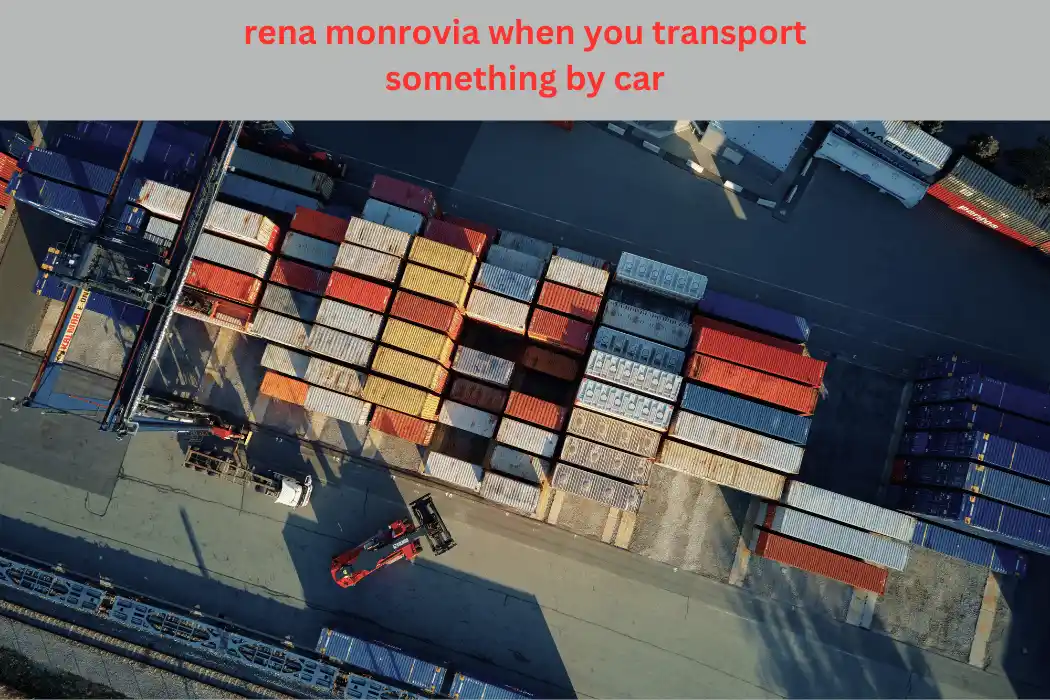Whether you’re a business owner, work in logistics, or simply need to move a car, understanding efficient car transport is key. In her blog, Rena Monrovia dives deep into the car transport process, offering valuable insights, practical tips, and important considerations to ensure a smooth journey for your vehicle.
Evolutionary History of rena monrovia when you transport something by car
The journey of car-based transportation, from its humble beginnings in the late 1800s, is a captivating tale of innovation that continues to this day. Rena Monrovia When You Transport Something by Car delves into the fascinating evolution of car-based transportation, highlighting the continuous innovation in moving goods. Early workhorses like station wagons and pickup trucks revolutionized local deliveries, offering unparalleled flexibility and affordability for small businesses. The early 20th century saw another leap forward with the introduction of robust freight trucks, spearheaded by Ford’s designs. This, coupled with the expansion of highways, paved the way for interstate trucking, becoming the lifeblood of reaching distant markets and transforming national commerce. The post-war era witnessed a further transformation with the development of the interstate highway system, creating a seamless network for efficient long-distance travel. Finally, the 1960s saw the rise of containerization and GPS tracking, revolutionizing logistics and optimizing fleet operations for the trucking industry. Tracing this evolution highlights not only the ingenuity behind car-based transportation but also its profound impact on shaping our economic landscape.
Read more about The How Of Digital And Analytics In Insurance.
Our journey with vehicular transport, from the plodding pace of horse-drawn carriages to the futuristic promise of self-driving trucks, showcases humanity’s relentless innovation in moving goods. This evolution has not only fueled global trade but also dramatically improved our quality of life.

Tips for Rena Monrovia When You Transport Something by Car
- Protect items from scratches by wrapping them in a blanket or sheet.
- Secure delicate items in sturdy boxes with ample cushioning.
- Distribute heavy objects carefully and evenly for safe transport.
- Ensure clear visibility when reversing or turning with heavy loads by using mirrors or asking for help.
- Drive with caution, anticipating potential stops, to minimize the need for sudden braking.
Key Considerations for Rena Monrovia in Car Transport
Safeguarding your goods is paramount when transporting them by car. As Rena Monrovia advises, careful planning and preparation are essential. First, assess the fragility, size, and weight of your cargo to determine the appropriate packing and securing methods. Proper labeling helps ensure safe handling throughout the journey. Second, ensure everything fits within your car’s dimensions and weight limits, adhering to any relevant regulations. Double-check measurements for bulky or heavy items. Finally, for valuables or antiques, document any existing damage with photographs before loading them.
Delicate and Practical Objects
Planning is key to transporting fragile items safely in your car. Rena Monrovia, a transportation expert, emphasizes the importance of proper packing and handling to minimize damage. For items like glassware, pottery, electronics, or artwork, take extra care. Utilize original packaging whenever possible, or choose sturdy containers filled with cushioning materials like crumpled paper, bubble wrap, or foam peanuts. Securely seal the boxes, fill any empty spaces, and clearly label them as “fragile.” To prevent items from shifting during transport, secure the boxes and ensure they’re loaded evenly in the trunk. Maintain a smooth driving experience by avoiding sudden acceleration or braking. Bulky items can be placed between boxes for stability. Delicate boxes should be kept upright and cushioned with blankets, pads, or airbags. Always follow the manufacturer’s instructions for specific items, and slow down when encountering bumps or rough roads.
Perishable Consumables
When dealing with perishable goods in commerce, navigating the complexities of temperature control and suitable vehicles becomes paramount. As highlighted by Rena Monrovia, transporting items with a limited shelf life requires careful planning and specialized equipment. Unlike standard cargo, perishables necessitate a deep understanding of temperature control solutions to ensure they arrive fresh at their destination.
Strategic Route Planning and Key Sailing Destinations
The secret weapon in any successful vehicle transport operation is a well-crafted route plan. By employing advanced navigation tools, savvy drivers can transform deliveries from a gamble to a science. These tools factor in real-time traffic patterns, road closures, and potential detours, allowing drivers to navigate around obstacles and ensure smooth, timely deliveries. This strategic approach minimizes delays and keeps your cargo on schedule.
Smart Tips and Tricks for Maximizing Fuel Efficiency and Connectivity
If you’re looking to lighten your wallet and your environmental footprint, Rena Monrovia has the answer: fuel-efficient driving. Her book and blog are packed with practical tips to help you get the most out of every gallon. Regular maintenance, as recommended by your car’s manufacturer, keeps your engine and tires in top shape, maximizing fuel efficiency. Simple adjustments to your driving habits can also make a big difference. Reducing unnecessary weight in your car, maintaining moderate speeds, and utilizing highway cruise control all contribute to lower fuel consumption. For even greater savings, minimize idling, turn off the engine when parked for short periods, and use air conditioning sparingly. Planning your trips to minimize errands and considering hybrid or electric vehicles can further reduce your environmental impact. By following Rena Monrovia’s advice, you can save money at the pump and contribute to a cleaner planet.
Large Item Carrying Device
Car roof racks are lifesavers when it comes to transporting bulky cargo. They free up precious space inside your vehicle while allowing you to securely carry even the heaviest items.
This version emphasizes the benefits of roof racks without explicitly mentioning there are six points to follow.
- This focuses on the ability to carry oversized items.
- This combines the efficient use of roof space with the benefit for passengers.
- This focuses on the security aspect of using a roof rack.
- This emphasizes how roof racks prevent damage to the car’s interior from large items.
- This emphasizes the versatility of roof racks.
Car roof racks aren’t just for road trips and moving days! They transform your everyday driving. Whether you’re hauling sports equipment for the weekend game or groceries for a big cookout, roof racks expand your car’s capabilities. Need some extra space without renting a truck or trailer? Roof racks offer a cost-effective solution, freeing up precious interior room and keeping your adventures organized. Invest in a roof rack and unlock a trunk full of possibilities!
Available Car Luggage Carriers: Market Overview
When it comes to hauling hefty cargo, car roof racks or cargo carriers are your lifesavers. They come in a variety of sizes and styles, ensuring there’s a perfect fit for whatever you need to transport.
Roof Boxes: Perfect for long journeys, offering ample storage for luggage, camping gear, or sporting equipment. Available in various sizes to match your car and cargo needs.
Hitch-Mounted Cargo Carriers: Simple to install and remove, these carriers extend your car’s cargo space. Perfect for hauling heavy items like bikes, coolers, or toolboxes.
Cargo Boxes: These secure, weatherproof containers attach to either hitch or roof carriers, providing additional storage that protects your gear from the elements.
Trunk Carriers: These affordable carriers offer additional cargo space without requiring a hitch or roof rack. They simply mount onto your car’s trunk or hatch.
Choosing the right car luggage carrier requires some planning. Before you buy, carefully review weight limits and installation requirements to ensure compatibility with your vehicle. Consider your car’s type and the size and shape of the cargo you plan to transport. A well-fitted carrier is essential for safety – Consumer Reports highlights that poorly installed roof racks can increase the risk of accidents. Remember, your car’s capabilities extend beyond just your emotional baggage!
Benefits of Using Car Roof Racks for Transport
discover the advantages of luggage carriers!
- Car luggage carriers are your answer to cramped trunks. Enjoy the extra storage space for all your gear.
- These carriers are crafted from water-resistant materials, keeping your belongings safe from the elements during your travels.
- Car luggage carriers often feature compartments or cargo bags for easy organization of your belongings.
- Enjoy the convenience of hassle-free loading and unloading with car luggage carriers.
The landscape of car-based logistics has been revolutionized by technology and machinery, as Rena Monrovia highlights. Gone are the days of guesswork and manual processes. GPS has become an indispensable tool, optimizing routes with real-time traffic data and providing constant location tracking. Fleet monitoring systems elevate efficiency even further, seamlessly connecting drivers with dispatchers and offering real-time cargo status updates. Furthermore, smartphone apps streamline the entire delivery process, allowing for effortless scheduling, coordination, and confirmation. Safety takes a leap forward as well, with advanced driver-assistance features like lane-keeping assist, automated braking, and adaptive cruise control becoming increasingly common. These advancements, championed by Rena Monrovia, demonstrate how technology is undeniably reshaping the world of car transportation.
Technology is transforming car-based transportation from the ground up, leading to a more sustainable, efficient, and streamlined industry. As Rena Monrovia emphasizes, electric vehicles and alternative fuels are paving the way for a greener future. Inventory sensors ensure precise cargo temperature monitoring, while digital records minimize paperwork and save valuable time. Standardized containerization simplifies loading and unloading, further optimizing the process.
Technological integration goes beyond the vehicle itself. Route planning software powered by GPS and real-time data helps determine the most efficient routes, considering factors like traffic, road conditions, tolls, and potential hazards. This meticulous planning, particularly for long-haul trips, extends to optimizing refueling stops, rest breaks, meals, and driver changes. Being prepared for detours, delays, and potential vehicle issues is also crucial. Finally, verifying delivery addresses and phone numbers before departure ensures a smooth and timely arrival.

